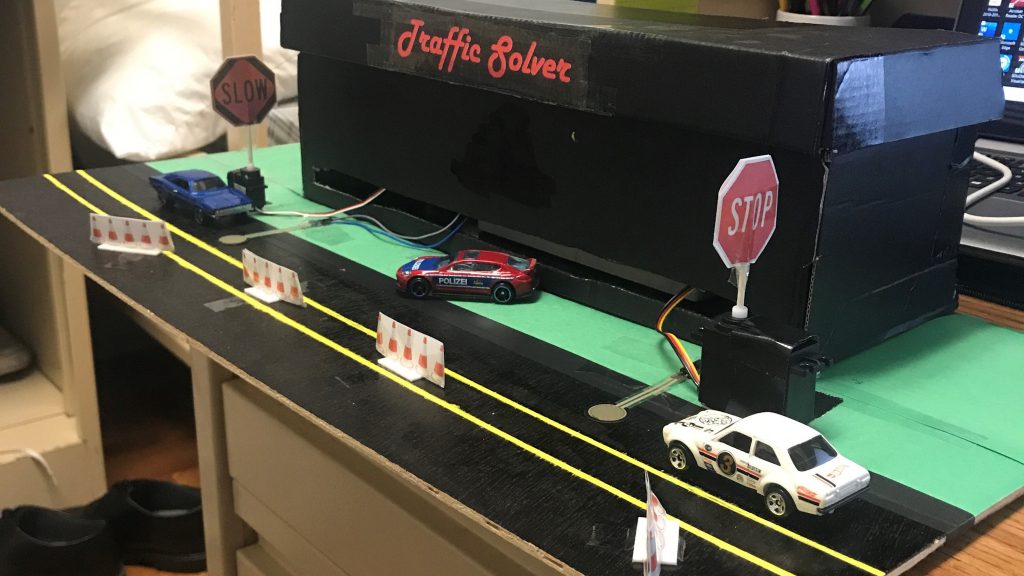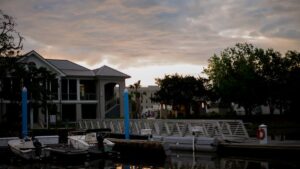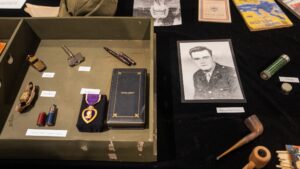
Photo: A prototype of Citadel cadets’ “traffic solver” concept.
As seen in The Post and Courier, by Jeff Hartsell
You see them at both ends of a traffic construction zone, workers holding up “stop” and “slow” signs to direct traffic.
There’s got to be a better way, right?
A group of mechanical engineering students at The Citadel may have come up with that better way and are looking to push their concept into the mainstream.
The team of four cadets is one of five finalists in the military college’s Baker Business Bowl, a program similar to the popular “Shark Tank” TV show. The Business Bowl competition is designed to budding entrepreneurs who have an idea for a new product or service and the desire to turn that idea into a business.
The competition is open to cadets, evening undergraduate students and graduate students.
The finalists will be judged in April, with the winning team earning $10,000 to spend on its project, and the runner-up getting $5,000.
For the “Traffic Solver” team of cadets, that would mean a chance to scale up their potentially life-saving system. According to workzonesafety.org, there were 754 fatalities and 671 fatal crashes in work zones in the U.S. in 2018.
“The system we’ve all seen out there is not very efficient and not safe for the people out there on the work site,” said cadet Jack Pyrtiz, a senior from Raleigh, N.C. “About 90 percent of road work is done at night, and you’ve got workers out there close to traffic and turning signs.
“The idea is to remove them, get them to a safer place where they can actually work on the project and finish the project more quickly.”
The “Traffic Solver” system uses two robot signs that can interact with each other through a computer code, using pressure sensors to count the cars as they enter and exit the work zone.
“When the vehicle runs over the pressure sensors, the weight of the vehicle will be registered by the code,” said senior Huntor Ross of Hampstead, Md. “The flow in has to match the flow out in order for the signs to change direction and change the flow of traffic.
“The customer could also a program a timer in the system. If a normal traffic light is about three minutes, you could program the code for that time, depending on the traffic flow on that road. And there’s a safety feature so that if someone runs the stop sign and is going against the flow of traffic, it will register the count and turn both signs to stop while sending a signal to the customer to warn them.”
The team has built a small-scale prototype using toy cars but says it will easy to build to scale.
“The main issue with the project is the code,” Ross said. “Once you have the program down, it will be simple to build a bigger scale system.”
Cadet Zach Blackburn, a senior from Lexington, said the design could have other uses outside of work zones.
“It could also be useful in public safety, for hurricanes and other emergencies,” he said. “If there’s a power outage knocking out traffic lights, for example, you could implement this system.”
Other concepts in the Baker Business Bowl finals are an app to help 18-wheelers navigate restricted roads; a robot to help officials inspect bridges; a machine to recycle water filters; and a multi-functional 3D printing device.
The team has built a small-scale prototype using toy cars but says it will easy to build to scale.
“The main issue with the project is the code,” Ross said. “Once you have the program down, it will be simple to build a bigger scale system.”
Cadet Zach Blackburn, a senior from Lexington, said the design could have other uses outside of work zones.
“It could also be useful in public safety, for hurricanes and other emergencies,” he said. “If there’s a power outage knocking out traffic lights, for example, you could implement this system.”
Other concepts in the Baker Business Bowl finals are an app to help 18-wheelers navigate restricted roads; a robot to help officials inspect bridges; a machine to recycle water filters; and a multi-functional 3D printing device.
The finals are set for April 16.

 The Citadel’s Swain Boating Center provides popular event space for Charleston
The Citadel’s Swain Boating Center provides popular event space for Charleston The Citadel Board of Visitors reelects chair
The Citadel Board of Visitors reelects chair The Citadel Museum honors alumnus killed on D-Day
The Citadel Museum honors alumnus killed on D-Day

